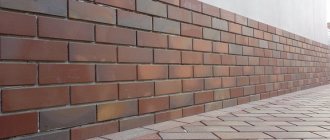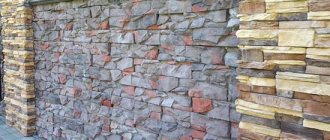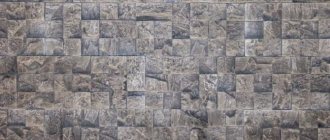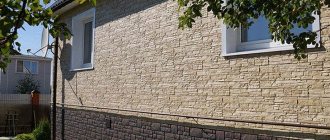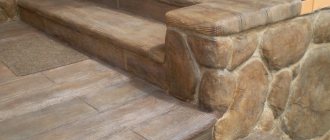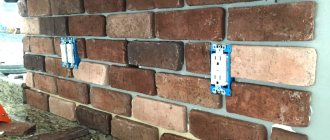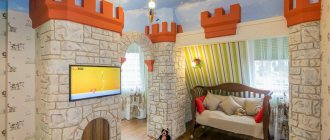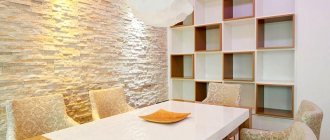Advantages of finishing with plinth stone
Finishing the basement of a private house with artificial stone has its advantages and disadvantages. The huge advantages include:
- resistance to high humidity and even flooding;
- resistance to temperature changes ;
- no matter how massive it may look, it is light in weight , which is important when calculating the load on the foundation;
- cheap material;
- long service life;
- Flame resistant
- wide selection of stone designs;
- ease of installation.
If we talk about the shortcomings, then they are all a consequence of a violation of the technology of the manufacturing and installation process of the base.
Decorating a house with artificial stone Source en.yenni.biz
Varieties
Manufacturers produce a wide range of materials for finishing the base element. Artificial stone is divided according to decor, internal composition, and color scheme.
The following varieties can be noted:
- flexible;
- cement;
- polymer sand;
- tile;
- homemade.
The choice depends on the installation location and the main material of the facade. The necessary indicators of thermal insulation and protection from the effects of power are taken into account.
Flexible
The material contains 2 layers of polymers. It is available in both piece tiles and rolls. The cladding has the following parameters and advantages:
Light weight.- High flexibility for finishing façade plinths with complex shapes and textures.
- Resistant to steam and moisture.
- Resistance to extreme temperatures.
- Resistance to temperature changes.
- Easy installation.
- One of the most economical materials.
The material is easy to install. It can be cut, including cutting out individual pieces of trim from anywhere. The outer side is additionally protected with film. It is used during transportation, storage, and installation work.
The main disadvantage is the fairly high cost for an artificial composition. Flexible stone is suitable for any base. The main thing is to ensure reliable fixation.
Cement
This is a budget analogue of natural material. Cement facing stone has positive properties:
- resistance to negative temperatures;
- protection from the formation of mold and mildew;
- not affected by precipitation;
- characterized by increased frost resistance and high strength characteristics;
- Long service life with regular and proper care.
If large vertical surfaces are provided, the base is pre-reinforced. The stone is secured to an anchor, as it has a lot of weight. Please note that the finished structure will not adhere to the adhesive composition.
Tile
Base tiles are made from special types of clay . It undergoes high temperature processing. The result is a durable product with high-quality protection against external factors.
The decorative surface can imitate not only natural stone, but also brickwork. As a result, you can choose an option for your own home, taking into account personal preferences, facade decoration, roofing and fence.
The tile has the following parameters and advantages:
- Resistance to thermal influences.
- Increased water impermeability.
- Weather protection.
- Resists temperature changes.
- Retains original shape and appearance.
- Protection from mechanical impact.
The cladding is characterized by long-term operation without additional complications. It is relatively expensive for a material of non-natural origin. At the same time, the quality of the coating is preserved for a long time.
Polymer sand
This is a composite material that is used for finishing facades and basement elements. It is made from a sand mixture with polymer additives and plasticizers. The latter improve the performance of the finished composition. Thanks to the selected composition, a decorative coating appears that replicates the external design and structure of natural stone.
For convenient fastening, the plates are equipped with locking connections. During installation, it is enough to prepare the frame by leveling the surface in one plane. The tiles are secured to the frame using ordinary self-tapping screws. Despite its lightness, polymer sand stone has increased strength characteristics and protects the building from heat loss.
The product has positive characteristics and an affordable price . However, it does not have the flexibility of some artificial materials. For this reason, it is important to prepare the frame in advance to create a level base.
Homemade
This is the most economical, but labor-intensive material for installation. You will need cement mortar to apply to the base. The surface is covered with a thick layer of the mixture. At the final stage, the relief of the stone is drawn using a specialized hook.
Advantages of self-made stone coating:
- reliable adhesion to the surface of the base;
- Durability proven by time;
- No leveling is required before covering with cladding.
The finished result only resembles a stone or copies it exactly. After complete hardening, the surface is coated with paint to give the desired shade. The varnish is then treated for maximum protection.
Type of artificial stone
There is a wide range of cladding materials. Decorative stone for finishing the base of a house differs not only in color and shape, but also in the materials from which it is made.
Flexible plinth stone
Consists of two layers of polymer material. It is produced in the form of a roll and piece tiles. This type of cladding has the following characteristics:
- thanks to its flexibility, it is possible to decorate facades with complex textures ;
- very light weight ;
- resistant to high temperatures, fireproof;
- vapor permeable;
- moisture resistant;
- resistant to temperature changes;
- long life ;
- economical during installation;
- easy to install.
This material can be easily mounted to almost any type of façade; it can be conveniently cut with scissors; individual elements can be cut from the overall fabric to accentuate finishing fragments. It is worth noting that the front side of the material is covered with a protective film; it is removed only after installation work is completed.
The disadvantages of this material include its rather high price.
Flexible base stone Source otthondepo.hu
Stone made of polymer-sand mixture
Thanks to the special composition of sand and polymer materials, this type of material is no different in appearance from real stone. Cladding the base of a house with artificial stone made from a polymer-sand mixture has the same characteristics as flexible cladding. The only difference is the lack of flexibility of the material and increased heat capacity. The plinth can be covered with this material on any surface. The tiles are attached to the sheathing and have tongue-and-groove fastenings between each other.
Artificial concrete facing stone
This material was one of the first to appear as an alternative to natural stone. It was very popular for a long time and is still in demand. Concrete facing stone has a number of positive characteristics:
- resistant to fungal formations;
- resistant to sub-zero temperatures;
- long service life with timely care.
This type of stone is made from a mixture of ordinary concrete and plasticizer. Large elements must be reinforced. Such a stone is attached to special anchors, since due to its heavy weight, the material will not adhere to cement-adhesive mixtures.
Artificial facing stone made of concrete Source tvoydom.netdo.ru
Clinker tiles
Clinker stone for cladding the base of a house is created from special types of clay by firing in a kiln at high temperature. This type of material imitates a wide variety of textures, from stone cuts to brickwork. Most often they are produced in the form of piece elements and panels with a tongue-and-groove fastening system. Clinker tiles have a number of advantages:
- resistance to temperature changes ;
- resistance to high humidity ;
- high resistance to sudden climate changes;
- resistance to fading in the sun;
- little susceptible to mechanical stress .
The main disadvantage is the price of the material, but due to its long service life, this price is more than justified.
Clinker stone is created from clay Source remlandia.ru
See also: Catalog of companies that specialize in insulation and finishing of houses.
Decorative layer of concrete “like a stone”
The simplest and most affordable way to decorate the foundation. A thick layer of concrete is applied to the foundation, and then the corresponding relief is applied with special tools. The finishing layer is applied with paint and varnish for a more attractive look.
It is worth noting that when choosing to cover the foundation of a house with artificial stone, one should take into account a number of factors that significantly affect the performance characteristics of a particular type of decorative finish.
Stone-like concrete Source remont.gatezone.ru
Finishing the base with artificial stone using tile adhesive
Laying artificial stone with tile adhesive is one of the most common options for cladding a plinth. But first you need to prepare the following tools:
- brush;
- roulette;
- container for water, glue and grout preparation;
- mixer drill with attachment;
- trowel and spatula;
- several brushes;
- syringes for applying grout;
- building level;
- cutting machine.
Don’t forget to prepare the necessary material.
Next, the cladding work involves following the following steps:
- Preparation of the base surface. This work is relevant if significant irregularities are detected. In this case, they must be plastered. Next, you should consistently apply at least two layers of primer, which in the future will ensure good adhesion of the glue to the base surface.
- Preliminary marking. To begin with, it is worth determining which stones will be placed in specific places. At this stage, special attention will have to be paid to the top of the base and the corners. Experienced specialists first lay out artificial stones in the same way in which they will be fixed to the base surface. This will also allow you to check how well they fit together and whether there are any gaps between them. It is also advisable to ensure that there are no significant deviations in the color scheme. All shades should shimmer smoothly.
- Cleaning the inner surface of artificial stone with a brush from cement milk, which has a foamy light layer.
- Production of tile adhesive. To do everything correctly, you must strictly adhere to the recommendations that are written in the instructions on the package. To mix everything well, you should definitely use a mixer. Only in this way will the master be able to obtain a homogeneous composition, which in the future will affect the practicality and durability of the finishing of the base.
- Next, a layer of tile adhesive must be applied to the back side of the artificial stone element using a spatula. Its thickness should be no more than 8-9 mm. At this stage, it is very important not to leave any places on the surface that will not be covered with the composition.
- Now you can carefully attach the artificial stone elements to the base. At the same time, it is better to move it a little in different directions to ensure good adhesion to the base surface. Afterwards, it is necessary to remove excess glue so that it does not remain at the joints between the finishing elements.
Tips for choosing a stone
- Price . High-quality material cannot cost much less than natural stone. If the price is significantly lower, there is a risk of buying a defective or low-quality product.
- When choosing a cement-based stone, it is worth asking what form it was cast in. A silicone mold is best suited for these purposes.
- Pay attention to the coloring . Different colors should have clear boundaries, and the paint should be distributed evenly and throughout the entire depth. This will provide you with a beautiful appearance of the base even if chips or potholes form during operation.
- The finishing material must be smooth and solid , there must be no chips, holes or gouges. This indicates gross violations in the manufacture of the material.
- Special grooves should be applied on the back side of the tiles for better adhesion to the glue.
- The material in the form of tiles must have clear and even edges .
- Age of the house and foundation . The older the foundation, the lighter the facing material should be. Before installation, a thorough foundation investigation should be carried out. If we are talking about cladding a new building, then the material is chosen based on the type of foundation itself and the decorative appearance.
Artificial stone must be smooth and solid
Source docplayer.es
Nuances of choosing decorative stone
When choosing a material, the following parameters are taken into account:
- Superb view.
- Compliance with installation technology.
- Functional and technological connection with blind areas, since when facing it is important to ensure normal moisture release and thermal insulation.
- Compliance with the architectural solution.
The material meets the parameters of environmental safety and environmental protection. There should be no chips, damage or cracks on the surface. The color of individual strips must match the rest.
